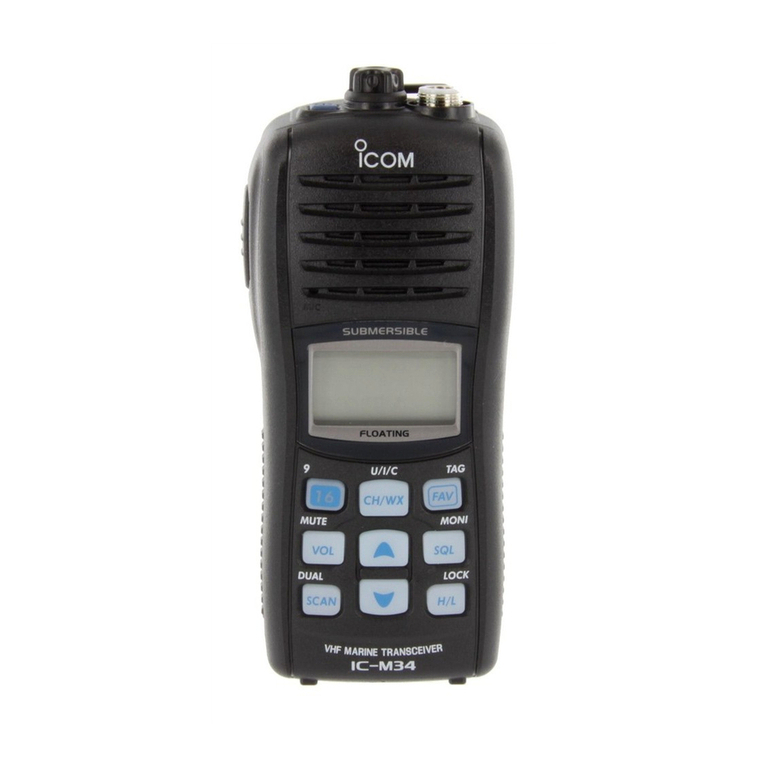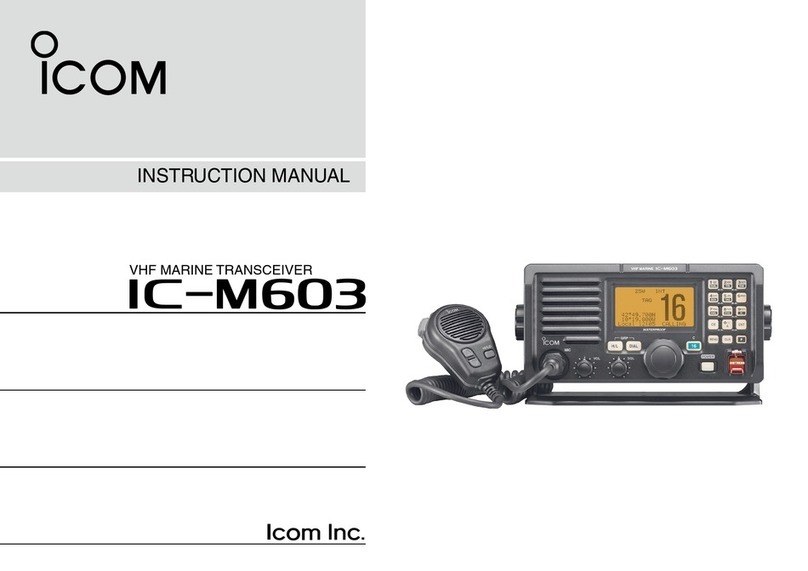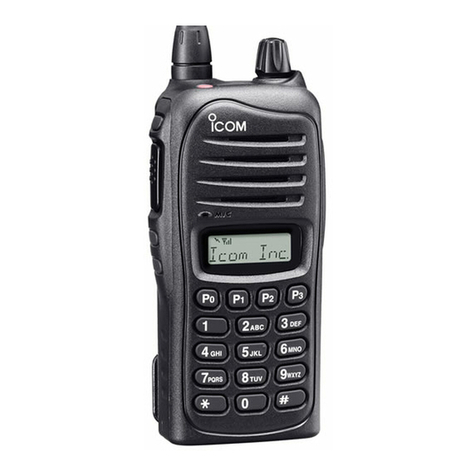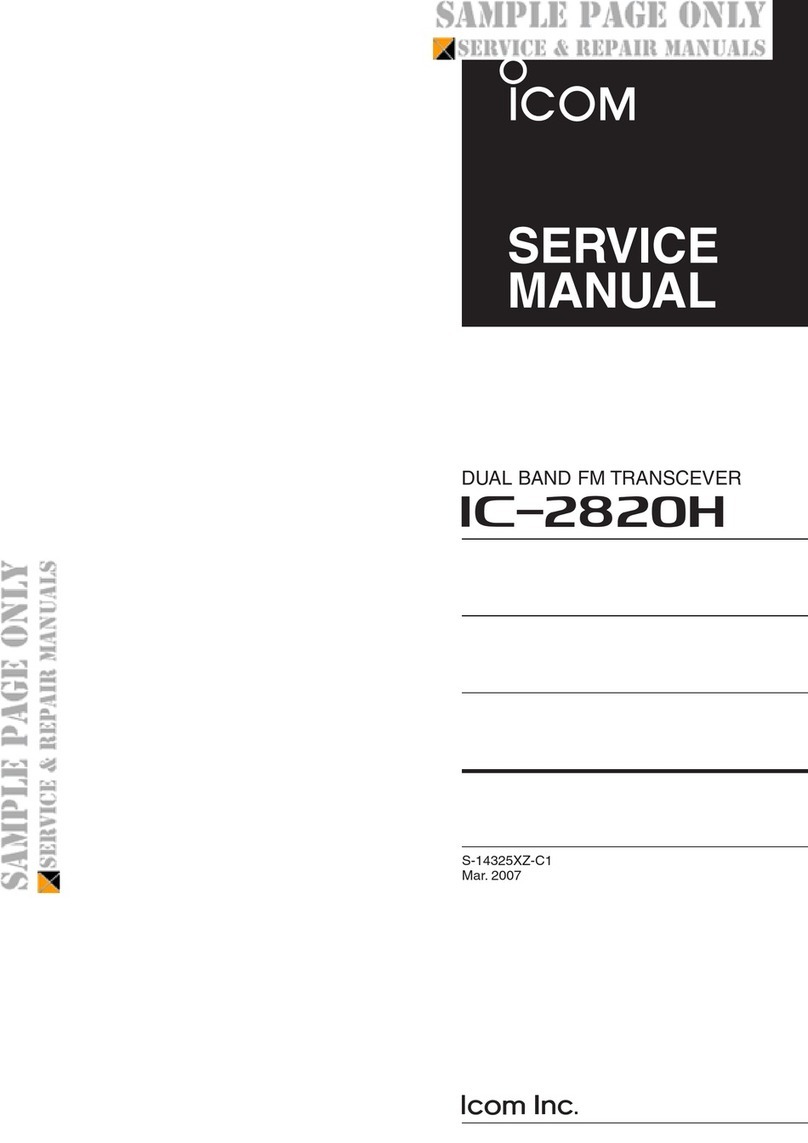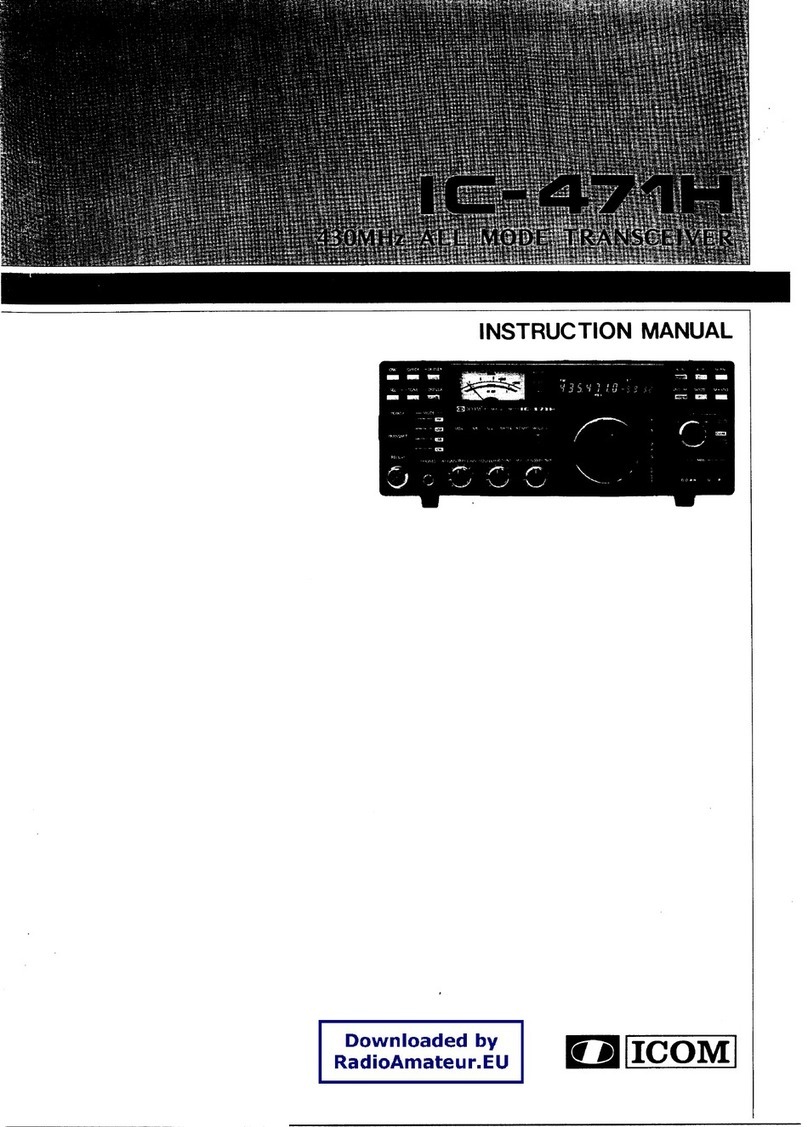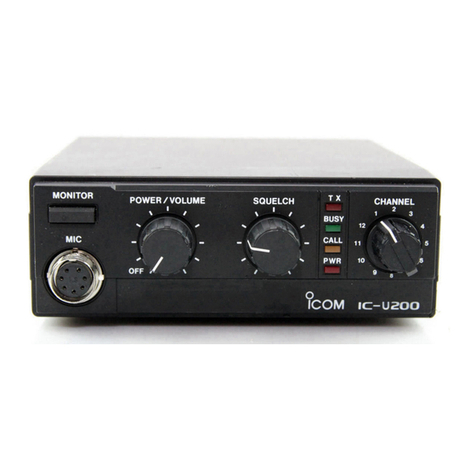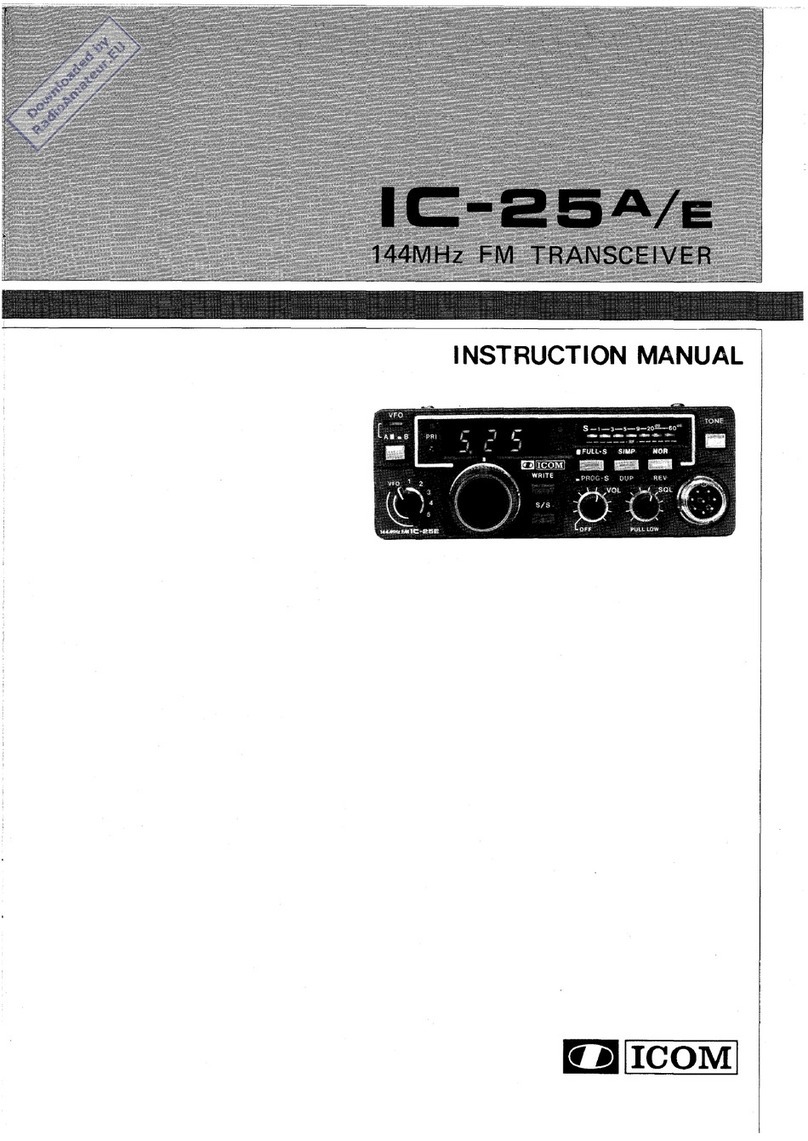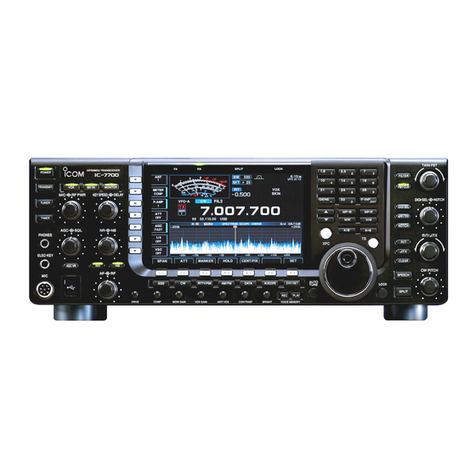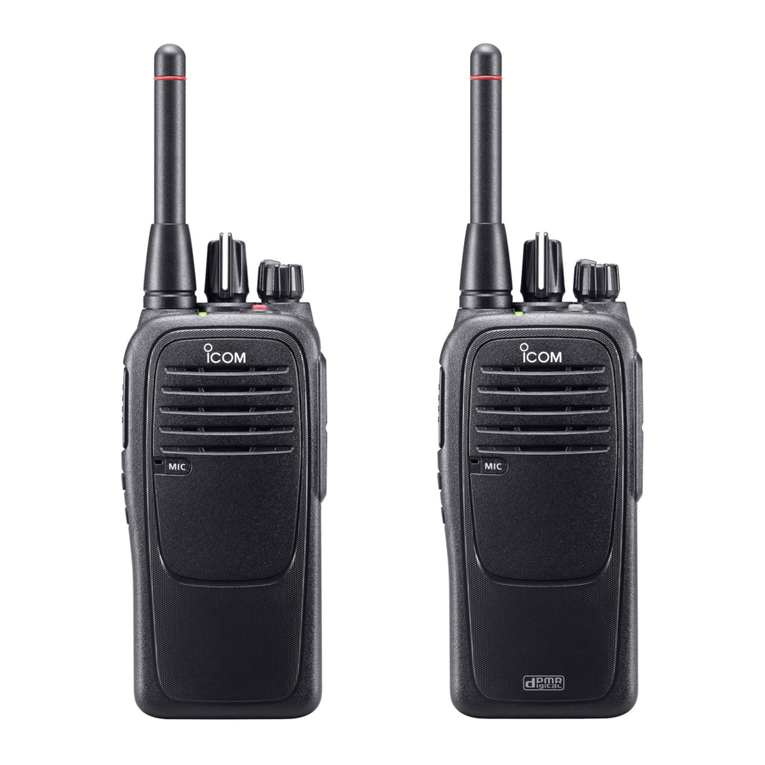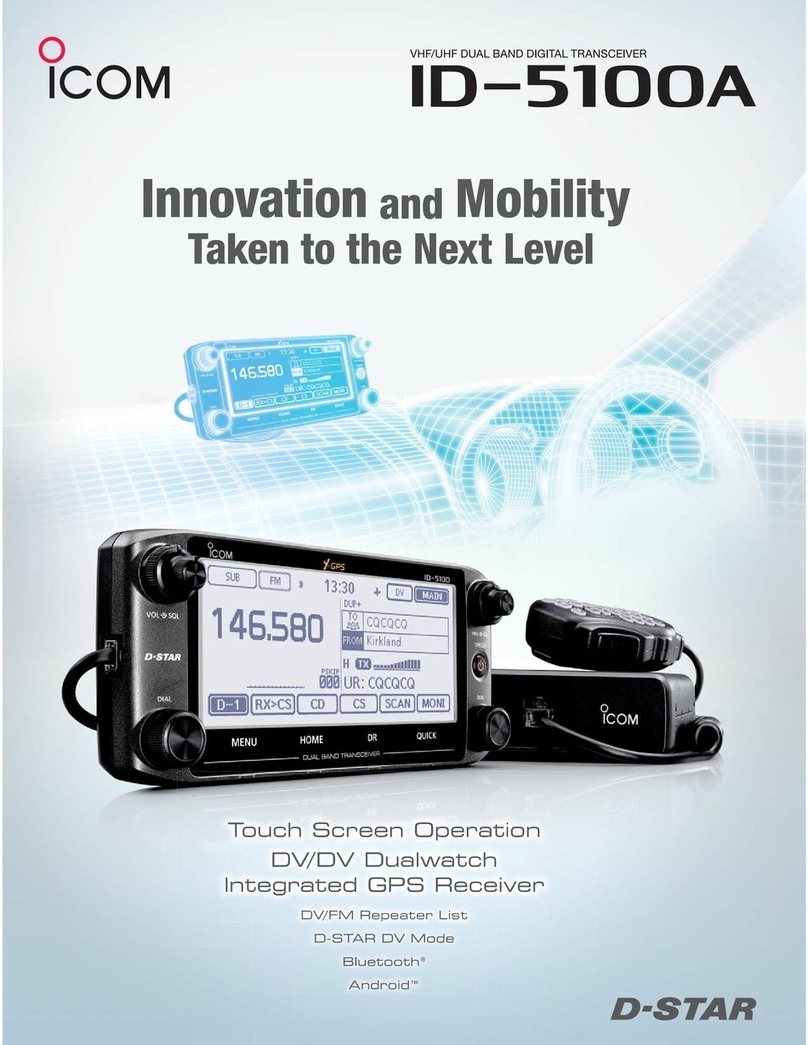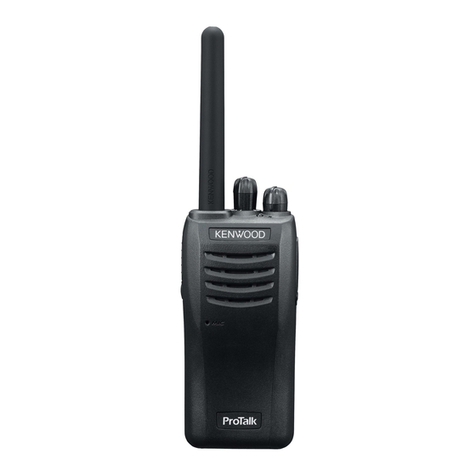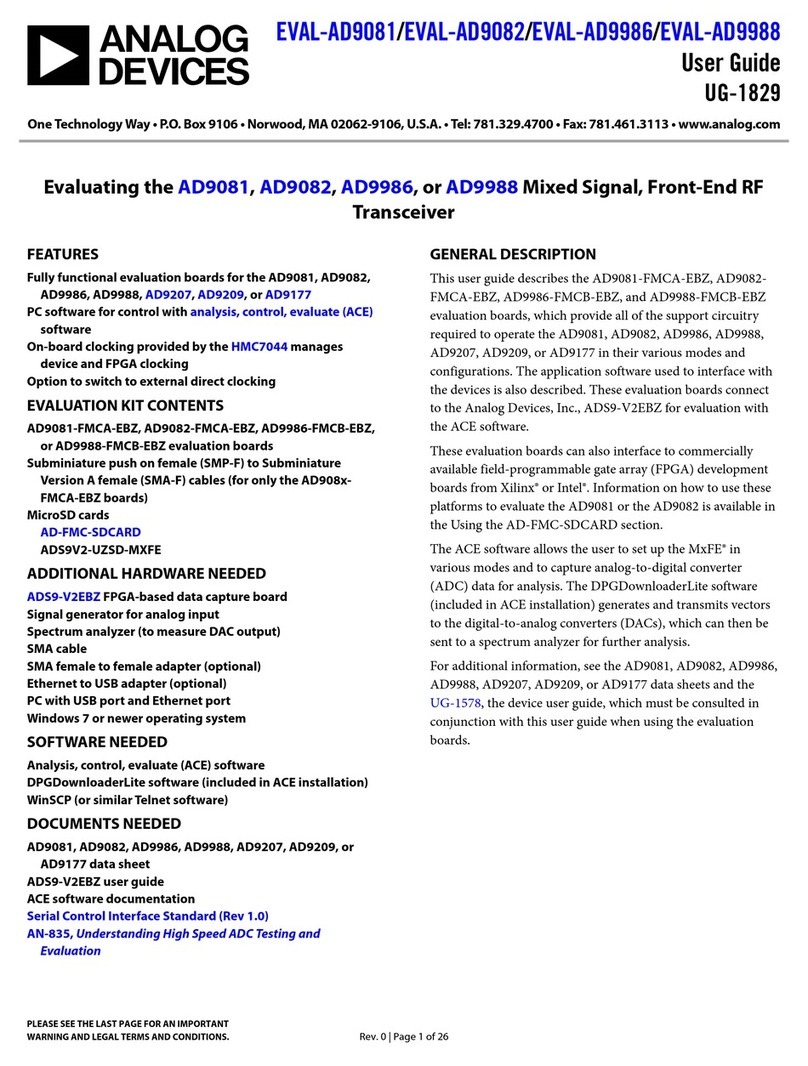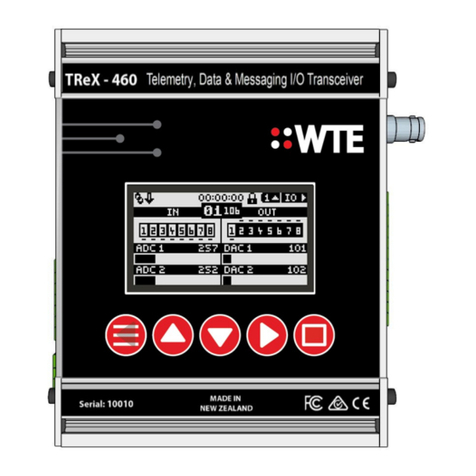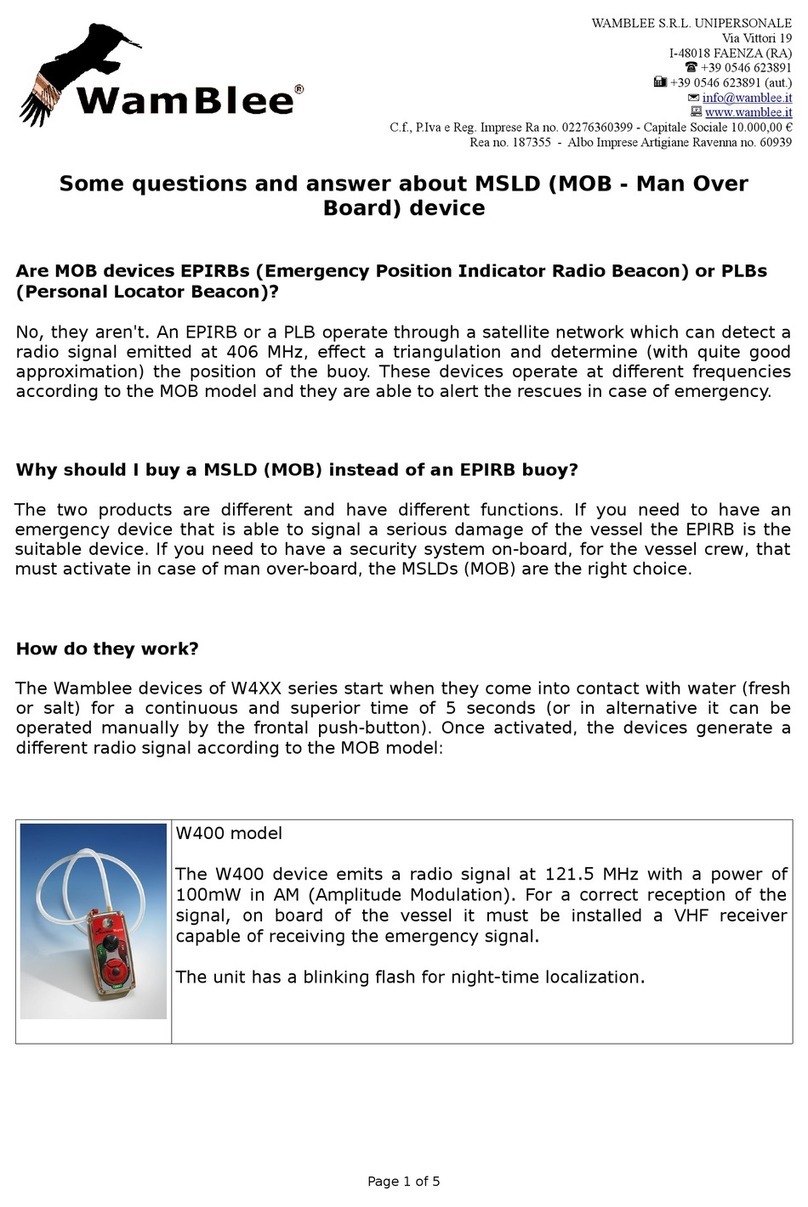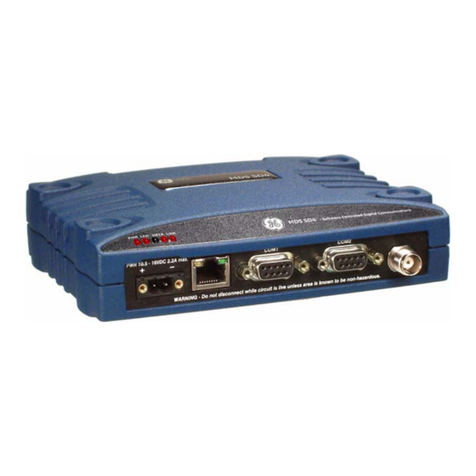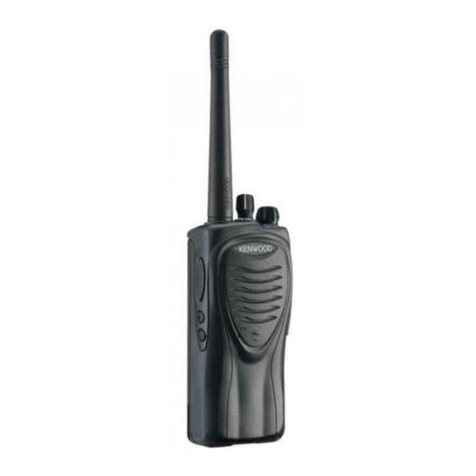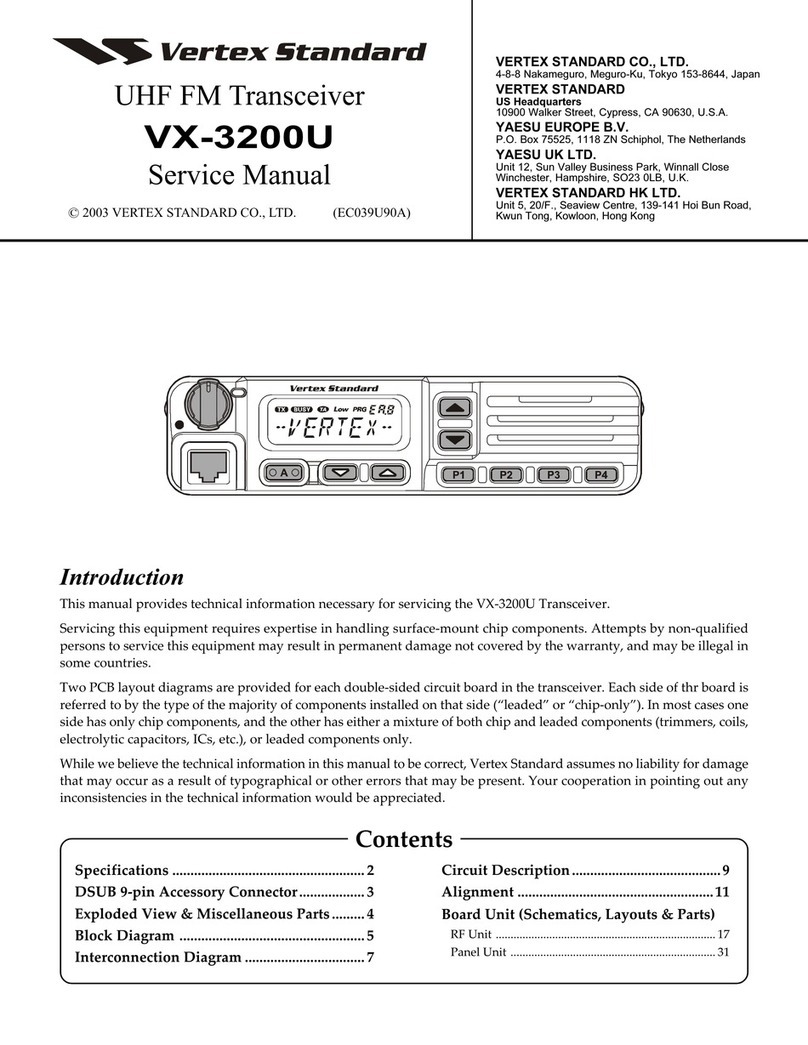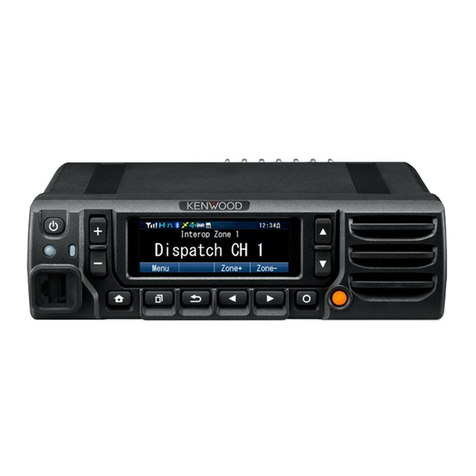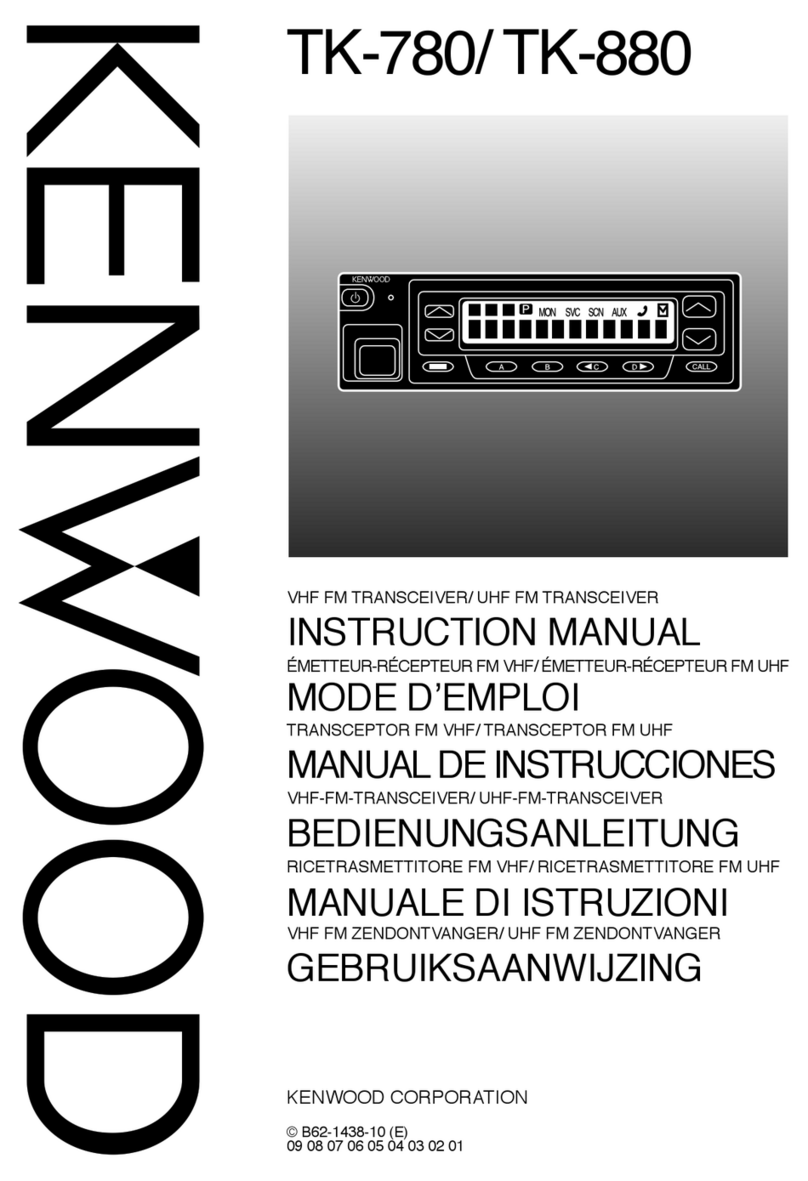Icom IC-M36 User manual

лчиттничюнльтцию.
глтчн.Бзвыдны
www.sotmarket.ru
дбняинфмциятв,
тзывы,бзыиы
Инструкция для
Icom IC-M36
Перейти в карточку товара
8 800 775 98 98

INSTRUCTION MANUAL
iM36
VHF MARINE TRANSCEIVER
This device complies with Part 15 of the FCC
Rules. Operation is subject to the condition that
this device does not cause harmful interference.

i
Your Icom radio generates RF electromagnetic energy during
transmit mode. This radio is designed for and classified as
“General Population Use” in an uncontrolled environment.
This radio has been evaluated for compliance at the distance
of 2.5 cm (1 inch) with the FCC RF exposure limits for “
Gen-
eral Population Use
”. In addition, your Icom radio complies
with the following Standards and Guidelines with regard to RF
energy and electromagnetic energy levels and evaluation of
such levels for exposure to humans:
• FCC OET Bulletin 65 Edition 01-01 Supplement C,Evaluating Compli-
ance with FCC Guidelines for Human Exposure to Radio Frequency
Electromagnetic Fields.
•
American National Standards Institute (C95.1-2005), IEEE Standard
for Safety Levels with Respect to Human Exposure to Radio Frequency
Electromagnetic Fields, 3 kHz to 300 GHz.
•
American National Standards Institute (C95.3-2002), IEEE Recom-
mended Practice for the Measurement of Potentially Hazardous Electro-
magnetic Fields– RF and Microwave.
• The
following accessories are authorized for use with this product. Use of
accessories other than those specified may result in RF exposure levels
exceeding the FCC requirements for wireless RF exposure.; Belt Clip
(MB-109), Rechargeable Li-Ion Battery Pack (BP-252) and Alkaline Bat-
tery Case (BP-251).
To ensure that your expose to RF electromagnetic en-
ergy is within the FCC allowable limits for general popu-
lation use, always adhere to the following guidelines:
•
DO NOT operate the radio without a proper antenna attached, as this
may damaged the radio and may also cause you to exceed FCC RF ex-
posure limits. A proper antenna is the antenna supplied with this radio by
the manufacturer or antenna specifically authorized by the manufacturer
for use with this radio.
•
DO NOT transmit for more than 50% of total radio use time (“50% duty
cycle”).Transmitting more than 50% of the time can cause FCC RF expo-
sure compliance requirements to be exceeded. The radio is transmitting
when the “transmit indicator” appears on the LCD.You can cause the
radio to transmit by pressing the “PTT” switch.
•
ALWAYS keep the antenna at least 2.5 cm (1 inch) away from the body
when transmitting and only use the Icom belt-clips which are listed on
p. 28 when attaching the radio to your belt, etc., to ensure FCC RF
exposure compliance requirements are not exceeded. To provide the re-
cipients of your transmission the best sound quality, hold the antenna at
least 5 cm (2 inches) from your mouth, and slightly off to one side.
The information listed above provides the user with the information needed
to make him or her aware of RF exposure, and what to do to assure that this
radio operates with the FCC RF exposure limits of this radio.
Electromagnetic Interference/Compatibility
During transmissions, your Icom radio generates RF energy that can possibly
cause interference with other devices or systems.To avoid such interference,
turn off the radio in areas where signs are posted to do so. DO NOT operate
the transmitter in areas that are sensitive to electromagnetic radiation such as
hospitals, aircraft, and blasting sites.
i
SAFETY TRAINING INFORMATION
WARNING
CAUTION

ii
IN CASE OF EMERGENCY RECOMMENDATION
If your vessel requires assistance, contact other vessels and
the Coast Guard by sending a distress call on Channel 16.
❍USING CHANNEL 16
DISTRESS CALL PROCEDURE
1.“MAYDAY MAYDAY MAYDAY.”
2.“THIS IS ……………… ” (name of vessel)
3.Your call sign or other indication of the ves-
sel.
4.“LOCATED AT …………… ” (your position)
5.The nature of the distress and assistance
required.
6. Any other information which might facilitate
the rescue.
CLEAN THE TRANSCEIVER THOROUGHLY WITH FRESH
WATER after exposure to saltwater, and dry it before opera-
tion. Otherwise, the transceiver's keys, switches and control-
lers may become unusable due to salt crystallization.
NOTE: DO NOT wash the transceiver in water if there is any
reason to suspect the waterproof protection may not be ef-
fective. For example, in cases where the battery pack rubber
seal is damaged, the transceiver/battery pack is cracked or
broken, or has been dropped, or when the battery pack is
detached from the transceiver.

FOREWORD
Thank you for purchasing this Icom radio. The IC-M36 VHF
MARINE TRANSCEIVER is designed and built with Icom’s state of
the art technology and craftsmanship. With proper care this
radio should provide you with years of trouble-free operation.
IMPORTANT
READ ALL INSTRUCTIONS carefully and com-
pletely before using the transceiver.
SAVE THIS INSTRUCTION MANUAL—This
instruction manual contains important operating instructions
for the IC-M36.
EXPLICIT DEFINITIONS
WORD DEFINITION
RWARNING Personal injury, fire hazard or electric
shock may occur.
CAUTION Equipment damage may occur.
NOTE
If disregarded, inconvenience only. No risk
of personal injury, fire or electric shock.
FEATURES
☞Floating on water
The transceiver floats on fresh or salt
water even when the supplied acces-
sories are attached.
• When a third-party battery pack, strap,
antenna, etc. is used, it may sink.
• The battery contacts may be prone to
rust if the transceiver is kept floating on
the water.
☞Clear voice boost
The transceiver has the noise detection function which
enables automatic volume adjustment and the volume
loud function that enables you to maximize the volume
level instantly to provide clear communication in the
noisy marine environments.
☞Noise cancelling microphone
The sub-microphone on the rear panel inverts the phase
and cancels out the ambient noise from the main micro-
phone. As a result, the transceiver can reduce the influ-
ence of the background noise (particularly treble noise)
on the transmitted signal.
• The noise cancellation can produce no effect according to con-
ditions such as loudness and type of noise, or the position and
distance between the noise source and the microphone, etc.
• The noise cancellation does not work when an optional exter-
nal speaker-microphone is connected.
iii

iv
RWARNING! NEVER connect the transceiver to an
AC outlet.This may pose a fire hazard or result in an electric
shock.
RWARNING! NEVER hold the transceiver so that
the antenna is closer than 2.5 cm (1 inch) from exposed
parts of the body, especially the face or eyes, while transmit-
ting. The transceiver will perform best if the microphone is
5 to 10 cm (2 to 4 inches) away from the lips and the trans-
ceiver is vertical.
NEVER connect the transceiver to a power source other
than the BP-251 (option) or BP-252. Such a connection will
ruin the transceiver.
DO NOT use or place the transceiver in direct sunlight
or in areas with temperatures below –20°C (–4°F) or above
+60°C (+140°F).
KEEP the transceiver out of the reach of children.
KEEP the transceiver at least 0.9 meters (3.0 ft) away
from your vessel’s magnetic navigation compass.
BE CAREFUL! The transceiver’s right-side panel will
become hot when operating continuously for long periods.
BE CAREFUL! The transceiver meets IPX7* require-
ments for waterproof protection. However, once the trans-
ceiver has been dropped, waterproof protection cannot be
guaranteed because of possible damage to the transceiver's
case or the waterproof seal.
* Only when the BP-251 (option) or BP-252, flexible antenna, [SP
MIC] cap is attached.
MAKE SURE the flexible antenna and battery pack are
securely attached to the transceiver, and that the antenna
and battery pack are dry before attachment. Exposing the
inside of the transceiver to water will result in serious dam-
age to the transceiver.
After exposure to water, clean the battery contacts thor-
oughly with fresh water and dry them completely to remove
any water or salt residue.
For U.S.A. only
CAUTION: Changes or modifications to this device, not
expressly approved by Icom Inc., could void your authority to
operate this device under FCC regulations.
Icom, Icom Inc. and the logo are registered trademarks of Icom Incor-
porated (Japan) in the United States, the United Kingdom, Germany, France,
Spain, Russia and/or other countries.
PRECAUTIONS

v
SAFETY TRAINING INFORMATION.................................................i
IN CASE OF EMERGENCY.............................................................ii
RECOMMENDATION....................................................................... ii
FOREWORD................................................................................... iii
IMPORTANT.................................................................................... iii
EXPLICIT DEFINITIONS................................................................. iii
FEATURES...................................................................................... iii
PRECAUTIONS............................................................................... iv
TABLE OF CONTENTS....................................................................v
1 OPERATING RULES ..................................................................1
2 SUPPLIED ACCESSORIES AND ATTACHMENTS...............2–3
■Supplied accessories...............................................................2
■Attachments.............................................................................2
3 PANEL DESCRIPTION...........................................................4–7
■Front, top, side and rear panels...............................................4
■Function display.......................................................................6
4 BASIC OPERATION .............................................................8–13
■Channel selection....................................................................8
■Receiving and transmitting ....................................................10
■Call channel programming.....................................................11
■Adjusting the volume level.....................................................11
■Volume loud function..............................................................12
■Volume mute function ............................................................12
■Adjusting the squelch level ....................................................12
■Lock function..........................................................................13
■Monitor function.....................................................................13
■Automatic backlighting...........................................................13
■AquaQuake water draining function.......................................13
5 SCAN OPERATIONSCAN OPERATION............................................................14–15
■Scan types.............................................................................14
■Setting TAG channels ............................................................15
■Starting a scan.......................................................................15
6 DUALWATCH/TRI-WATCH .......................................................16
■Description.............................................................................16
■Operation...............................................................................16
7 SET MODE..........................................................................17–20
■Set mode programming.........................................................17
■Set mode items......................................................................18
8 BATTERY CHARGING .......................................................21–24
■Battery caution.......................................................................21
■Supplied battery charger .......................................................23
■Optional battery case.............................................................23
■Optional battery charger........................................................24
9 OPTIONAL SPEAKER-MICROPHONE....................................25
■HM-165 descriptions..............................................................25
■Attachment.............................................................................25
10 TROUBLESHOOTING..............................................................26
11 VHF MARINE CHANNEL LIST.................................................27
12 SPECIFICATIONS AND OPTIONS...........................................28
■Specifications.........................................................................28
■Options ..................................................................................28
13 FCC INFORMATION.................................................................29
TABLE OF CONTENTS

D Priorities
• Read all rules and regulations pertaining to priorities and
keep an up-to-date copy handy. Safety and distress calls
take priority over all others.
• Y
ou must monitor Channel 16 when you are not operating
on another channel.
•
False or fraudulent distress calls are prohibited under law.
D Privacy
• Information overheard but not intended for you cannot law-
fully be used in any way.
•
Indecent or profane language is prohibited.
D Radio licenses
(1) SHIP STATION LICENSE
You must have a current radio station license before using
the transceiver. It is unlawful to operate a ship station which
is not licensed.
Inquire through your dealer or the appropriate government
agency for a Ship-Radiotelephone license application. This
government-issued license states the call sign which is your
craft’s identification for radio purposes.
(2) OPERATOR’S LICENSE
A Restricted Radiotelephone Operator Permit is the license
most often held by small vessel radio operators when a radio
is not required for safety purposes.
The Restricted Radiotelephone Operator Permit must be
posted or kept with the operator. Only a licensed radio op-
erator may operate a transceiver.
However, non-licensed individuals may talk over a trans-
ceiver if a licensed operator starts, supervises, ends the call
and makes the necessary log entries.
A current copy of the applicable government rules and regu-
lations is only required to be on hand for vessels in which a
radio telephone is compulsory. However, even if you are not
required to have these on hand it is your responsibility to be
thoroughly acquainted with all pertinent rules and regula-
tions.
NOTE: Even though the IC-M36 is capable of operation
on VHF marine channels 3, 21, 23, 61, 64, 81, 82 and
83, according to FCC regulations these simplex chan-
nels cannot be lawfully used by the general population in
U.S.A. waters.
1
1
OPERATING RULES
1
2
3
4
5
6
7
8
9
10
11
12
13
14
15
16

2
SUPPLIED ACCESSORIES AND ATTACHMENTS
2
■Supplied accessories
Battery packHandstrap
Belt clip
Battery charger
(with 2 screws)
Antenna
AC adapter*
(BC-147SA or BC-
174E depending
on the version)
■Attachments
DFlexible antenna
Connect the supplied flexible an-
tenna to the antenna connector.
CAUTION!
• NEVER carry the transceiver
by holding the antenna.
• T
ransmitting without an an-
tenna may damage the trans-
ceiver.
DHandstrap
Pass the handstrap through
the loop on the back side of
the transceiver as illustrated
at right. This facilitates carry-
ing.
DBelt clip
Attach/detach the belt clip to the transceiver as illustrated
below.
To attach the belt clip To detach the belt clip
Be careful!
Not to break
your nails.
w
q
* This illustration is described with the BC-147SA.

Screw position
when removing battery
Screw position
when attaching battery
Make sure the rubber seal (purple) is properly seated in the
groove and dust or other material does not adhere to it.
Battery pack Battery pack
Rubber seal
Groove
Correct position Incorrect position
NOTE:
When attaching a battery pack, make sure dust or other
material does not adhere to the rubber seal. If dust or other
material is on the seal when attaching a battery pack,
waterproof protection may not be guaranteed.
ïBattery pack
To remove the battery pack:
Turn the screw counter clockwise one quarter turn, then pull
the battery pack in the direction of the arrow as shown below.
To attach the battery pack:
Insert the battery pack in the transceiver completely, then
turn the screw clockwise one quarter turn.
NEVER remove or insert the battery pack when the trans-
ceiver is wet or soiled. This may result water or dust get-
ting into the transceiver/battery pack and may result in the
transceiver being damaged.
NOTE: When removing or attaching the battery pack, use
a coin or standard screwdriver to loosen or tighten the
bottom screw.
CAUTION!:
When attaching or removing a battery pack, make sure
the rubber seal is set in the groove of the battery pack
correctly. If the seal is not correctly in the groove, it may
be damaged when attaching the battery pack. If the seal
is damaged, waterproof protection is not guaranteed.
3
2
SUPPLIED ACCESSORIES AND ATTACHMENTS
1
2
3
4
5
6
7
8
9
10
11
12
13
14
15
16

4
PANEL DESCRIPTION
3
■
Front, top, side and rear panels
qANTENNA CONNECTOR (p. 2)
Connects the supplied antenna.
w
SPEAKER-MICROPHONE CONNECTOR [SP MIC] (p. 25)
Connects the optional external speaker-microphone.
NOTE: Attach the [SP MIC] cap when the optional
speaker-microphone is not used. Otherwise, water will
get into the transceiver.
qAttach the
[SP MIC]
cap.
wThen rotate it clockwise
completely.
q
w
e PTT SWITCH [PTT]
Push and hold to transmit; release to receive. (p.10)
rCHANNEL 16 KEY [16 9]
➥Push to select Channel 16. (p. 8)
➥
Push and hold for 1 sec. to select the call channel. (p.8)
➥When the call channel is selected, push and hold
for 3 sec. to enter the call channel programming
mode.(p.11)
➥While in the set mode, push to return to the normal
condition.(p.17)
Function
display
(pgs. 6, 7)
Speaker
y
t
r
e
u
w
q
!1
o
i
!0
Microphone !2
Sub-microphone
(p. iii)

t VOLUME/SQUELCH/MONITOR KEY [VOL/SQL MONI]
➥Push to enter the volume adjustment mode and the
squelch adjustment mode. (pgs. 11, 12)
➥Push to restore the changed volume level by the noise
detection, volume loud, or volume mute function to the
original. (pgs. 12, 20)
➥Push and hold for 1 sec. to activate the monitor func-
tion. (p. 13)
➥While pushing and holding this key, turn power ON to
enter the set mode. (p. 17)
➥While in the set mode, push to select an item. (p. 17)
ySCAN/DUAL KEY [SCAN DUAL]
➥Push to start or stop normal or priority scan. (p. 15)
➥
Push and hold for 1 sec. to enter the watch mode.(p.16)
➥Push to exit the watch mode. (p. 16)
➥Push and hold this key and
[Hi/Lo ]
, to activate the
Aq
uaQuake function. (p. 13)
uCHANNEL UP/DOWN KEYS [Y]/[Z]
➥Selects an operating channel.(pgs. 8, 9)
➥While in the set mode, selects the setting or value of an
item. (p. 17)
➥Checks TAG channels or changes scanning direction
during scan. (p. 15)
iFAVORITE/TAG KEY [FAVTAG]
➥Push this key to select the favorite (TAG) channels
with ignoring untagged channels in a channel group in
sequence. (p. 8)
➥Push and hold for 1 sec. to set or clear TAG for the
displayed channel. (p. 15)
➥While pushing and holding this key, turn power ON to
clear or set all TAG channels in the selected channel
group. (p. 15)
oCHANNEL/WEATHER CHANNEL KEY [CH/WX U/I/C]
➥Push to switch between the regular channel and
weather channel. (p. 9)
➥Push and hold for 1 sec. to select the channel group
from U.S.A., International and Canada. (p.9)
➥Push to return to the previous channel before selecting
Channel 16 or the call channel.
!0 TRANSMIT POWER/LOCK KEY [Hi/Lo ]
➥
Push to
select the output power
from high
and
low.
(p.10)
➥Push and hold for 1 sec. to turn the key lock function
ON or OFF. (p. 13)
!1 POWER KEY [ ]
Push and hold to turn power ON or OFF.
!2 LOUD/MUTE KEY [LOUD MUTE]
➥
Push to turn the volume loud function ON or OFF. (p.12)
➥Push and hold for 1 sec. to turn the volume mute func-
tion ON, and push to turn the function OFF.(p.12)
5
3
PANEL DESCRIPTION
1
2
3
4
5
6
7
8
9
10
11
12
13
14
15
16
Volume adjustment mode
Normal condition
Squelch adjustment mode
PUSH
PUSH
PUSH

6
3PANEL DESCRIPTION
■Function display
q TRANSMIT INDICATOR (p. 10)
Appears while transmitting.
w BUSY INDICATOR
➥Appears when receiving a signal or when the squelch
opens. (p. 10)
➥Blinks while monitoring. (p. 13)
e TAG CHANNEL INDICATOR (p. 15)
Appears when a TAG channel is selected.
r CALL CHANNEL INDICATOR (p. 8)
Appears when the call channel is selected.
t LOCK INDICATOR (p. 13)
Appears while the lock function is activated.
y BATTERY INDICATOR
Indicates remaining battery power.
Indication
Full Middle Charging
required No battery
Battery level
blinks when the battery is exhausted.
blinks when the battery is over charged.
u SCAN INDICATOR (p. 15)
Blinks during scan.
i DUALWATCH/TRI-WATCH INDICATORS (p. 16)
“DUAL” appears during Dualwatch; “TRI” appears during
Tri-watch.
o DUPLEX INDICATOR
Appears when a duplex channel is selected.
!0 SUB CHANNEL READOUT
➥Indicates Channel 16 during priority scan, Dualwatch or
Tri-watch. (p. 16)
➥Indicates the set mode item while in the set mode. (p. 17)
➥Indicates the volume level while in the volume adjust-
ment mode. (p. 11)
➥Indicates the squelch level while in the squelch adjust-
ment mode. (p. 12)
!5 !3!4
i
u
o
!2
!1
!0
!8
!6
q e r ytw
!7

!1 SQUELCH LEVEL INDICATOR
Shows the squelch level.
!2 VOLUME LEVEL INDICATOR
➥Shows the volume level.
➥The bars appear in ascending order repeatedly when
the volume loud function is activated. (p. 12)
➥Blinks while the volume mute is activated. (p. 12)
!3 VOLUME LEVEL ADJUSTING INDICATOR (p. 11)
➥Blinks while adjusting the volume level.
➥This indicator and the volume level indicator appear
alternately while the volume level is turned up by the
noise detection function. (p. 20)
!4 SQUELCH LEVEL ADJUSTING INDICATOR (p. 12)
Blinks while adjusting the squelch level.
!5 CHANNEL NUMBER READOUT
➥Indicates the selected operating channel number.
➥
In the set mode, indicates the selected condition or
value. (p. 17)
!6 CHANNEL GROUP INDICATOR (p. 9)
“ ” appears when U.S.A.; “ ” appears when Interna-
tional; “ ” appears when Canadian channel group is se-
lected each.
!7 WEATHER CHANNEL/WEATHER ALERT INDICATORS
(p. 9)
➥“WX” appears when the weather channel group is se-
lected.
➥“WX ALT” appears while the weather alert function is
activated;blinks when the alert tone is received.
!8 LOW POWER INDICATOR (p. 10)
➥“LOW” appears when low power is selected.
➥“LOW” blinks when switching forced low power mode
because of a high temperature error or low voltage.
7
3
PANEL DESCRIPTION
1
2
3
4
5
6
7
8
9
10
11
12
13
14
15
16

8
BASIC OPERATION
4
■Channel selection
IMPORTANT!: Prior to using the transceiver for the first
time, the battery pack must be fully charged for optimum
life and operation. To avoid damage to the transceiver,
turn the power OFF while charging.
DChannel 16
Channel 16 is the distress and safety channel. It used for
establishing initial contact with a station and for emergency
communications. Channel 16 is monitored during both Du-
alwatch and Tri-watch. While in the standby condition, you
must monitor Channel 16.
qPush [16 9] momentarily to select Channel 16.
wPush [CH/WX U/I/C] to return to the channel used before
Channel 16, or push [Y]/[Z]to select a channel.
Convenient!
While pushing and holding [FAVTAG], push [Y]/[Z] to select
the favorite (TAG) channels with ignoring untagged channels
in the selected channel group in sequence.
• Pushing[FAV TAG] only advances the displayed TAG channel.
• The favorite channels are selected using the TAG channel setting.
(p. 15)
DChannel 9 (Call channel)
Each regular channel group has separate leisure-use call
channels. The call channel is monitored during Tri-watch.
The call channels can be programmed (p. 11) and are used
to store your most often used channel in each channel group
for quick recall.
qPush and hold [16 9] for 1 sec. to select the call channel
of the selected channel group.
• “CALL” and call channel number appear.
• Each channel group may have an independent callchannel
after programming a call channel.(p. 11)
wPush [CH/WX U/I/C] to return to the channel used before
call channel, or push [Y]/[Z]to select a channel.
Push
Push and hold
for 1 sec.

DU.S.A., International and Canadian channels
The transceiver is pre-programmed with 59 U.S.A., 59 Inter-
national and 63 Canadian channels. These channel groups
may be specified for the operating area.
qPush [CH/WX U/I/C] to select a regular channel.
• If a weather channel appears, push[CH/WX U/I/C] again.
wPush and hold [CH/WX U/I/C] for 1 sec. to change the
channel group. Repeat to advance to the next group.
• U.S.A., International and Canadian channel groups can be se-
lected in sequence.
ePush [Y]/[Z]to select a channel.
• “DUP” appears for duplex channels.
Push and hold
U.S.A. channels
International channels Canadian channels
for 1 sec.
DWeather channels
The transceiver has 10 pre-programmed weather channels.
These are used for monitoring broadcasts from the NOAA
(National Oceanic and Atmospheric Administration).
The transceiver can automatically detect a weather alert
tone on the selected weather channel while receiving an-
other channel or during scan. (p.18)
qPush [CH/WX U/I/C] once or twice to select a weather
channel.
• “WX” appears when a weather channel is selected.
• “WX ALT” appears when the weather alert function is turned
ON. (p. 18)
wPush [Y]/[Z]to select a weather channel.
9
4
BASIC OPERATION
1
2
3
4
5
6
7
8
9
10
11
12
13
14
15
16
Push once or twice.
Weather alert is OFF. Weather alert is ON.

10
4BASIC OPERATION
■Receiving and transmitting
CAUTION: Transmitting without an antenna may damage
the transceiver.
q Push and hold []to turn power ON.
w Set the volume and squelch levels.
You can enter each adjust mode with [VOL/SQL MONI].
➥Enter the squelch adjustment mode, and push [Z]sev-
eral times to open the squelch.
➥Enter the volume adjustment mode, then push [Y]/[Z]
to adjust the volume level.
➥Enter the squelch adjustment mode again, and push
[Y]until the noise disappears.
e Push [Y]/[Z]to select the desired channel.
• When receiving a signal, “ ” appears and audio is emitted
from the speaker.
• Further adjustment of the audio may be necessary at this point.
r Push [Hi/Lo ]to select the output power if necessary.
• “LOW” appears when low power is selected; no indication when
high power is selected.
• Choose low power for short range communications,choose
high power for longer distance communications.
• Some channels are for low power only.
t Push and hold [PTT] to transmit, then speak into the
microphone.
• “ ” appears.
• Channel 70 cannot be used for transmission.
y Release [PTT] to receive.
IMPORTANT: To maximize the readability of your trans-
mitted signal, pause a few sec. after pushing [PTT], hold
the microphone 5 to 10 cm (2 to 4 inches) from your
mouth and speak into the microphone at a normal voice
level.
NOTE: The transceiver has a power save function to con-
serve the battery power. The power save function acti-
vates automatically when no signal is received for 5 sec.
For U.S.A version: To prevent accidental prolonged
transmission, etc., the transceiver has a time-out timer
function. This timer cuts a transmission OFF after 5 min.
of continuous transmission.
Microphone rSet output
power.
qPower ON.
tPush to
transmit.
yRelease to
receive. eSet channel.
Enter the volume
and squelch ad-
justment mode.
wwAdjust the
volume and
squelch
level.

■Call channel programming
Call channel is used to access Channel 9 (default), however,
you can program the call channel with your most often-used
channels in each channel group for quick recall.
qPush and hold [CH/WX U/I/C] for 1 sec. several times to
select the desired channel group (U.S.A., International or
Canada) to be programmed.(p.9)
wPush and hold [16 9] for 1 sec. to select the call channel
of the selected channel group.
• “CALL” and call channel number appear.
ePush and hold [16 9] again for
3sec. (until a long beep changes
to 2 short beeps) to enter the call
channel programming mode.
• Channel number starts blinking.
rPush [Y]/[Z]to select the desired
channel.
tPush [16 9] to program the dis-
played channel as the call chan-
nel.
• The channel number stops blinking.
■Adjusting the volume level
The volume level can be adjusted with [VOL/SQL MONI]
and [Y]/[Z].
qPush [VOL/SQL MONI] once to enter the volume adjust-
ment mode, then adjust the volume level with [Y]/[Z].
• “VOL” indicator starts blinking.
• The transceiver has 31 volume levels and OFF.
• With no key operation is performed for 5 sec., the transceiver
returns to the normal condition.
wPush [VOL/SQL MONI] twice to exit the volume adjust-
ment mode.
11
4
BASIC OPERATION
1
2
3
4
5
6
7
8
9
10
11
12
13
14
15
16
Indicates the
volume level.
Blinks while adjusting the volume level.

12
4BASIC OPERATION
■Volume loud function
The volume loud function can be activated temporarily by
pushing [LOUD MUTE].
The function does not work when the volume level is 31.
qPush [LOUD MUTE] to activate the volume loud function.
• The volume level is set to the maximum level (level 31).
• The bars of the volume level indicator appearsin ascending
order repeatedly.
wPush [LOUD MUTE] again, or push [VOL/SQL MONI] to
turn the volume loud function OFF.
■Volume mute function
The volume mute function can be activated temporarily by
pushing and holding [LOUD MUTE].
The function does not work when the volume level is OFF.
qPush and hold [LOUD MUTE] for 1 sec. to activate the
volume mute function.
• The volume level is set to the minimum level (OFF).
• The volume level indicator blinks.
wPush [LOUD MUTE] again, or push [VOL/SQL MONI] to
turn the volume mute function OFF.
■Adjusting the squelch level
The squelch level can be adjusted with [VOL/SQL MONI]
and [Y]/[Z].
In order to receive signals properly, as well as for the scan
to function effectively, the squelch must be adjusted to the
proper level.
qPush [VOL/SQL MONI] twice to enter the squelch adjust-
ment mode, then adjust the squelch level with [Y]/[Z].
• “SQL” indicator starts blinking.
• The transceiver has 11 squelch levels: OP is completely open;
10 is tight squelch; 1 is loose squelch.
• With no key operation is performed for 5 sec., the transceiver
returns to the normal condition.
wPush [VOL/SQL MONI] again to exit the squelch adjust-
ment mode.
Indicates the
squelch level.
Blinks while adjusting the squelch level.

■Lock function
This function electronically locks all keys (except for [PTT],
[VOL/SQL MONI],[LOUD MUTE], [Hi/Lo ]and [Y]/[Z]*)
to prevent accidental channel changes and function access.
* In the volume or squelch adjustment mode only.
➥Push and hold
[Hi/Lo ]
for 1 sec. to turn the lock func-
tion ON and OFF.
■Monitor function
The monitor function opens the squelch.The monitor key ac-
tion can be selected in the set mode.(p.19)
➥The monitor function is activated by pushing and holding
[VOL/SQL MONI] for 1 sec
.
• “ ” blinks and the squelch is opened.
■Automatic backlighting
This function lights the function display and keys, and it is
convenient for night-time operation.The automatic backlight-
ing can be activated in the set mode. (p.19)
➥
Push any key except for [PTT] to turn the backlight ON.
•
The backlight is automatically turned OFF after 5 sec. of inactivity.
■AquaQuake water draining
function
The AquaQuake water draining function clears water away
from the speaker grill.Without this function, water may muffle
the sound coming from the speaker. The transceiver emits a
vibrating beep when this function is activated.
➥Push and hold both [SCAN DUAL] and [Hi/Lo ].
• A low beep tone sounds for 9 sec. to drain water, regardless of
the volume level setting.
• The transceiver never accepts key operation while the
AquaQuake function is activated.
• The AquaQuake function can not be activated when an optional
speaker-microphone is connected.
13
4
BASIC OPERATION
1
2
3
4
5
6
7
8
9
10
11
12
13
14
15
16
Blinks while the monitor function is activated.
Push and hold
for 1 sec.
Appears while the lock function is activated.
Push and hold
for 1 sec.
Other manuals for IC-M36
2
This manual suits for next models
1
Table of contents
Other Icom Transceiver manuals
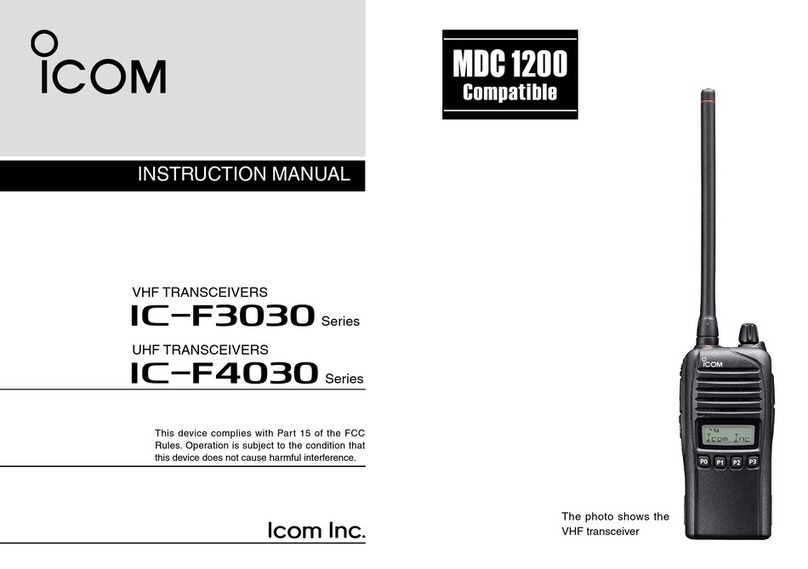
Icom
Icom IC-F3030 Series User manual
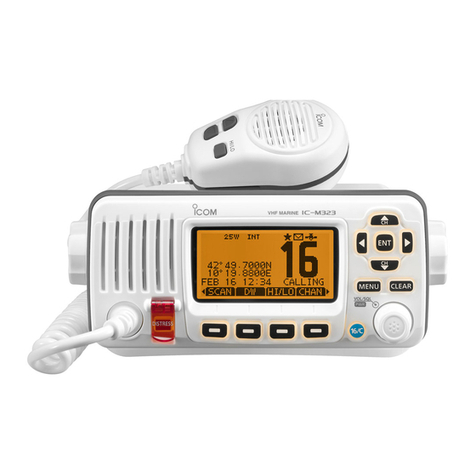
Icom
Icom IC-M323 User manual

Icom
Icom IC-R6 User manual
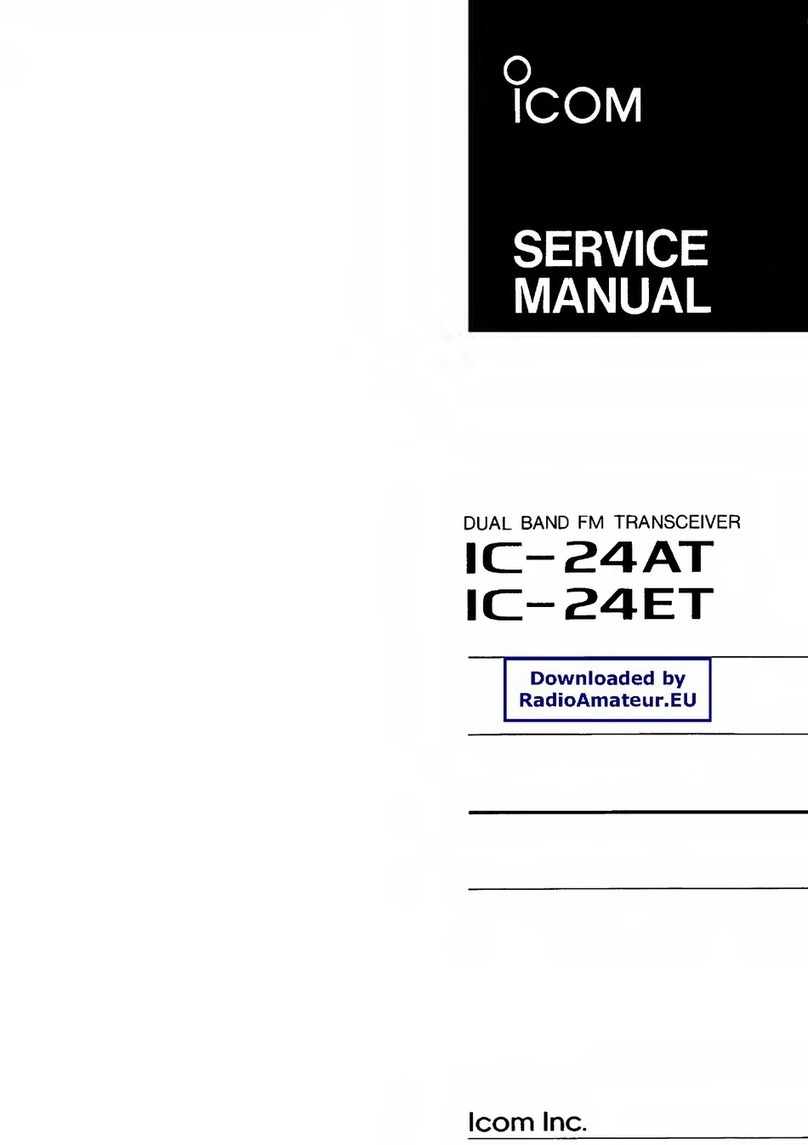
Icom
Icom IC-24AT User manual
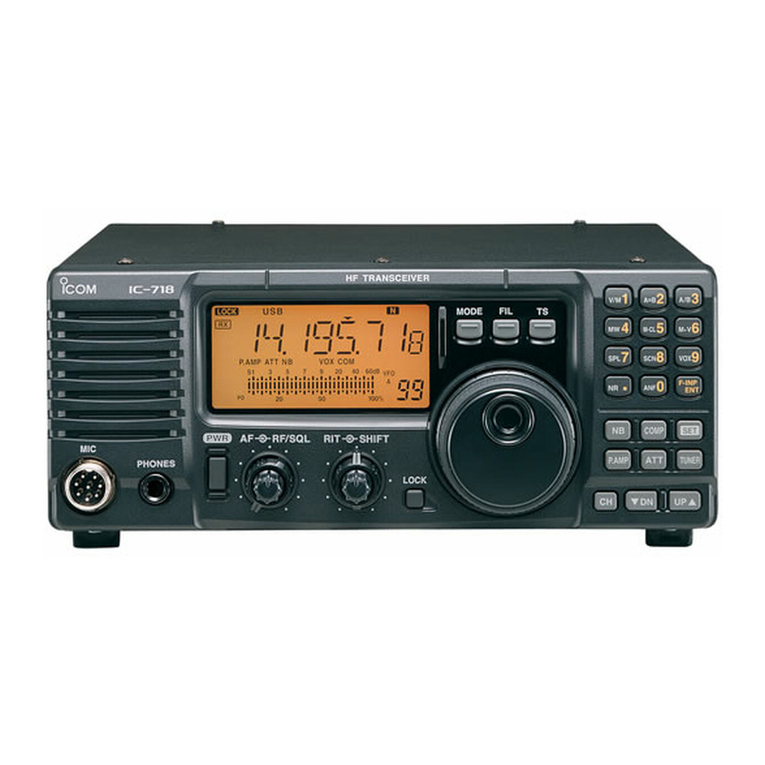
Icom
Icom IC-718 Installation and operating instructions
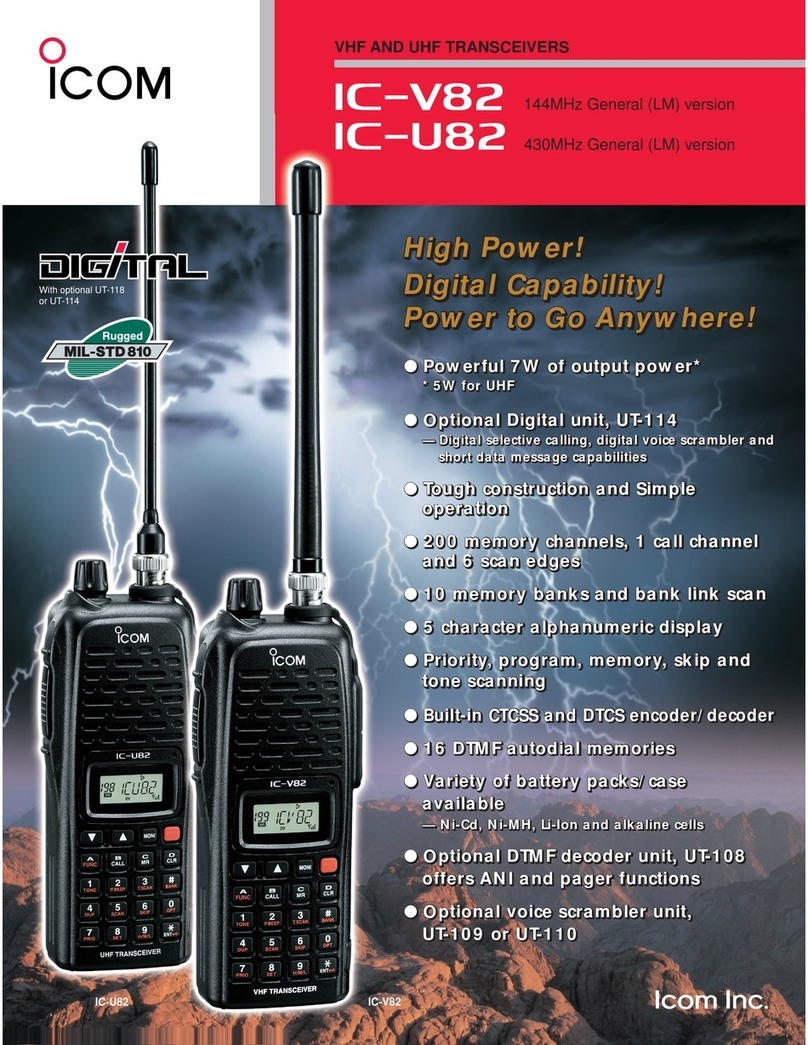
Icom
Icom IC-V82 User manual
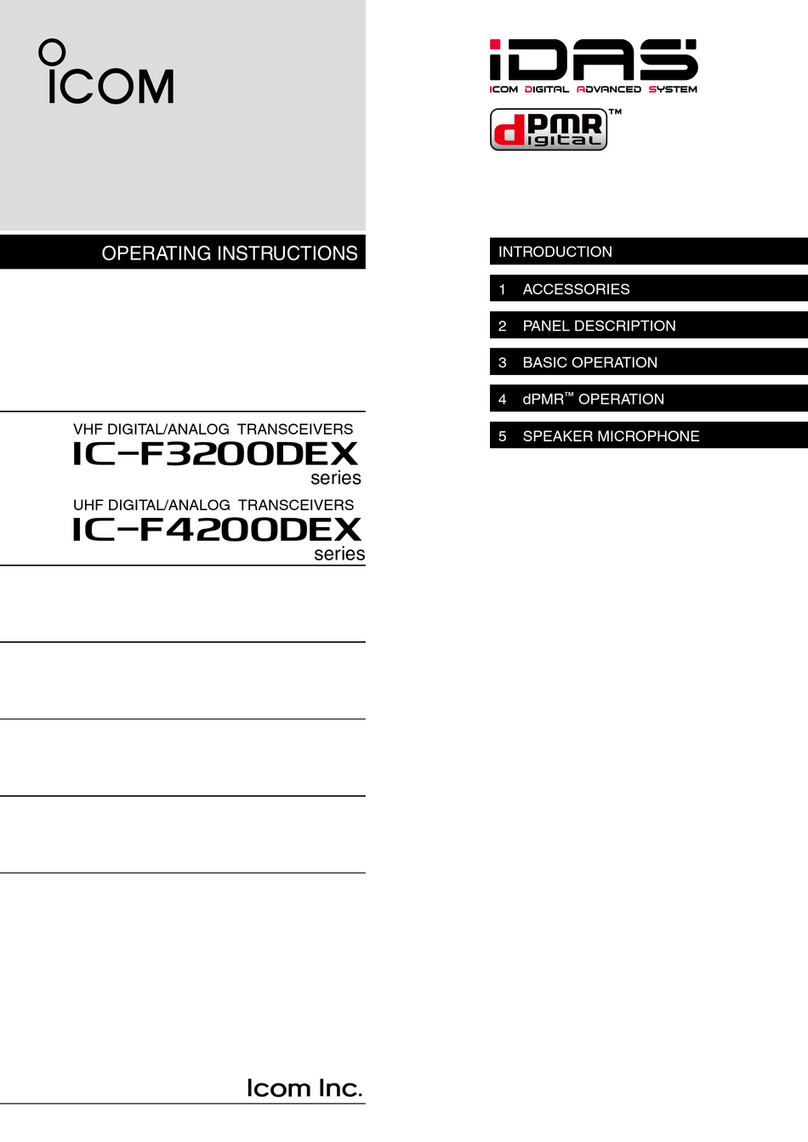
Icom
Icom IC-F3200DEX User manual
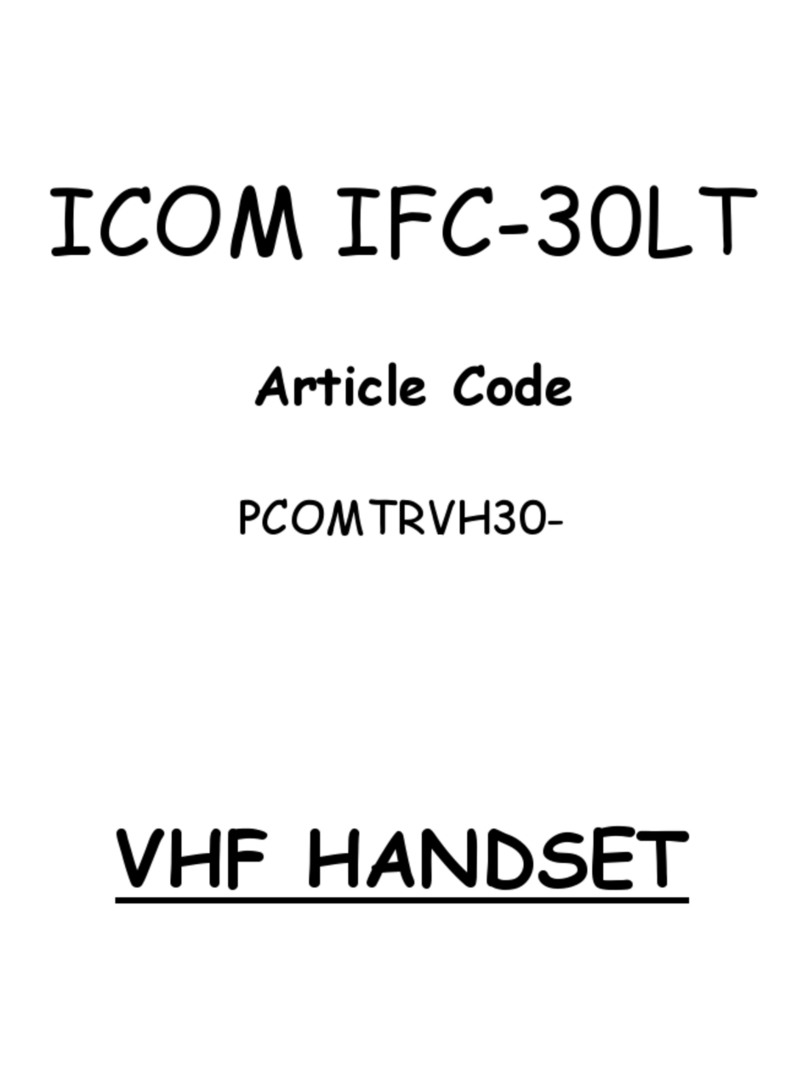
Icom
Icom IFC-30LT User manual
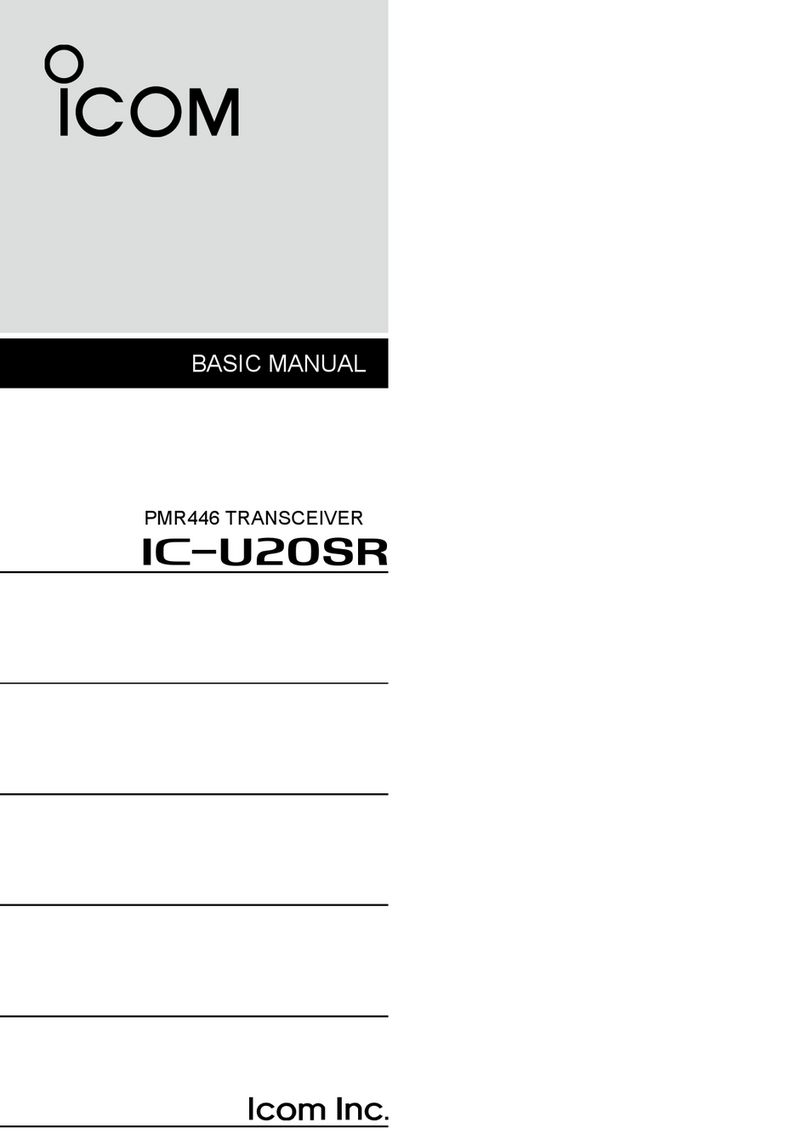
Icom
Icom IC-U20SR Installation guide
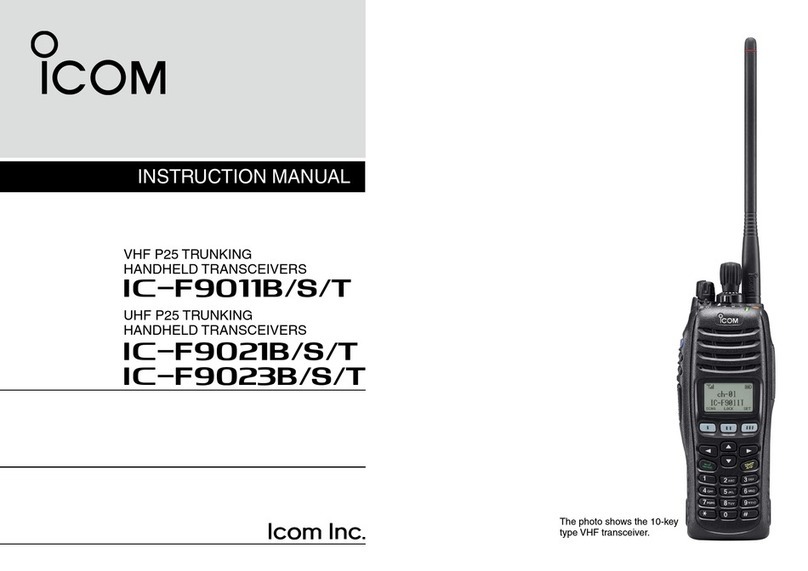
Icom
Icom IC-F9011B User manual
